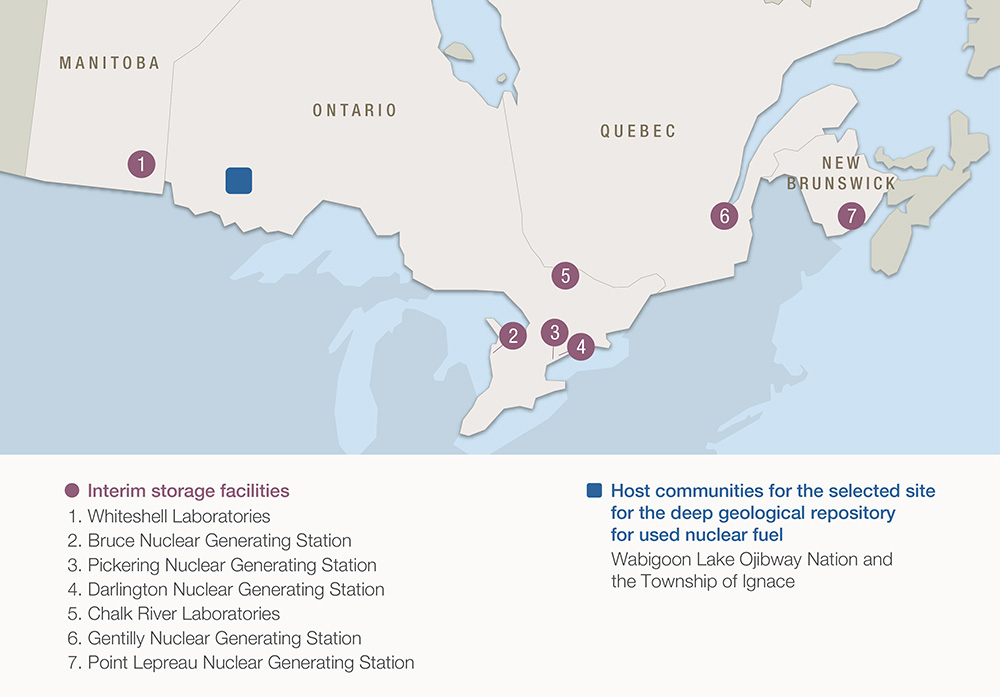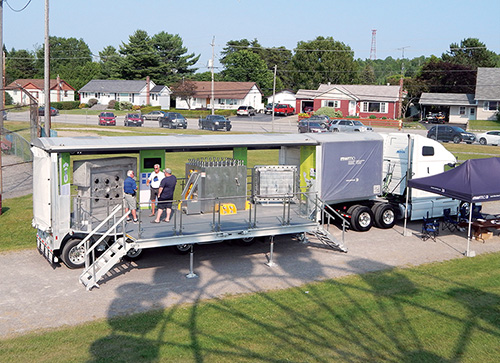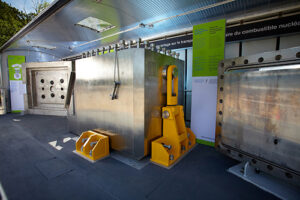TAC Sponsor Spotlight Article – Nuclear Waste Management Organization (NWMO)
By Caitlin Burley, Director of Transportation, NWMO; and
Ulf Stahmer, Senior Transportation Engineer, NWMO
In 2024, the Nuclear Waste Management Organization (NWMO) took a historic step by selecting a site for a deep geological repository to house Canada’s used nuclear fuel. This decision to site a deep geological repository in northwestern Ontario with Wabigoon Lake Ojibway Nation (WLON) and the Township of Ignace as two host communities was based on over 15 years of work with industry, government and many communities involved in the siting process. This is a significant step forward for Canada, and with it come many questions:
- Why does Canada need a deep geological repository?
- Is a deep geological repository the right solution?
- How will the used nuclear fuel be transported from where it’s currently located….and where IS it stored today?
- Is it safe to transport used nuclear fuel?
This article will provide a brief history of the NWMO’s siting decision, answer those common questions and describe how engagement on transportation played a significant role in achieving site selection.
Our history:
The NWMO launched its community-driven, consent-based site selection process in 2010. Originally, 22 communities stepped forward expressing an interest in learning more about becoming a host for a deep geological repository. Our process included clear commitments that Canada’s plan for used nuclear fuel would only move forward in an area with a site that meets rigorous safety standards and that has informed and willing hosts.
On November 28th, 2024, we announced that Wabigoon Lake Ojibway Nation (WLON) and the Township of Ignace were selected as the host communities for the future site for Canada’s deep geological repository for used nuclear fuel. This important decision for Canada was made possible because of the communities’ leadership and active engagement over a decade of learning, as well as considering the future of their communities. The safety of the site was also established through rigorous site assessment and technical studies.
Why does Canada need a deep geological repository?
Canada’s used nuclear fuel is currently stored above ground at reactor sites where it is produced. Storage at these sites is safe, but requires ongoing monitoring that adheres to rigorous Canadian and international standards. It was never intended to be long-term. The current containers have a lifespan of approximately 150 years, while the used fuel remains radioactive for hundreds of thousands of years. It is imperative that Canada develop a solution to contain and isolate used nuclear fuel for the long-term.
Is a deep geological repository the right solution?
Based on more than 50 years of research and dialogue between engineers, scientists and industry experts, international consensus is that deep geological repositories are industry best practice for the long-term management of used nuclear fuel. If you are interested in what is happening in other countries, Finland is leading the charge in deep geological design and construction and is in the final stages of construction (www.posiva.fi/en).
Where is the used fuel currently located, how will you move it and when?
Used fuel is currently stored in Ontario, Quebec and New Brunswick (see figure 1). The NWMO will begin transporting used nuclear fuel when the deep geological repository is operational, in the 2040’s, which is just under 20 years away. Given the long timeframes for transportation planning, the NWMO has developed a preliminary plan, which contemplates two systems:
- An all-road system; and
- A road-rail system.
Both systems will rely predominantly on existing road and/or rail infrastructure. Decisions will be made in the upcoming years about which system will be selected.

Is it safe to transport used nuclear fuel?
The short answer is ‘yes’. Used nuclear fuel is the most highly regulated substance transported in Canada and requires stringent oversight. It must be transported in packaging that is designed to withstand severe accident conditions, meets international standards set by the International Atomic Energy Agency and is certified by the Canadian Nuclear Safety Commission. A licence to transport used nuclear fuel must be obtained for each and every shipment and requires security and emergency response plans, including threat assessments. Additional driver training requirements, which take approximately 18 months to complete, are in place as well.
 Used fuel has been safely transported in Canada since the 1960s and is still transported in small amounts today (up to 5 shipments per year). Our transportation program will involve approximately 650 shipments per year. While that is a significant increase, it is comparable to many other highly radioactive shipments on our roads today. For example, approximately 30,000 Type B shipments took place in 2021. Type B packages are the types of packages required not only to transport used nuclear fuel, but also industrial gauges and measurement equipment and highly radioactive materials used to manufacture medical isotopes.
Used fuel has been safely transported in Canada since the 1960s and is still transported in small amounts today (up to 5 shipments per year). Our transportation program will involve approximately 650 shipments per year. While that is a significant increase, it is comparable to many other highly radioactive shipments on our roads today. For example, approximately 30,000 Type B shipments took place in 2021. Type B packages are the types of packages required not only to transport used nuclear fuel, but also industrial gauges and measurement equipment and highly radioactive materials used to manufacture medical isotopes.
Finally, in 60 years of transporting used nuclear fuel globally, there has never been an accident that has led to environmental or human harm as a result of radioactive release.
Transportation engagement as part of the siting decision
We know that transportation of used fuel (or any radioactive material) is a topic that concerns many people. People think of catastrophes like Chernobyl, Three Mile Island or Fukushima when they hear the word ‘nuclear’. In Canada, people’s experience with transportation accidents like Lac Mégantic and the Mississauga derailment and evacuation of 1979 also generates fear. Putting ‘nuclear’ and ‘transportation’ together understandably has a strong impact on people’s perception of the risks involved in transporting used nuclear fuel. Therefore, we have developed an engagement program focused on addressing those perceived risks. The program includes the following components:
Acknowledging people’s concerns about risk: Understanding and acknowledging is the first step to addressing fear and concerns. It is not helpful to dismiss what people are feeling by telling them they are wrong or ‘not to worry.’ People’s concerns and fears need to be understood so that we can begin to address them in a meaningful way. We have done this through years of public attitude research and What We Heard reports alongside a Transportation Planning Framework (the Framework) document that outlines what is most important to people in our planning process.
Addressing people’s concerns: We have almost 20 years to address people’s questions and concerns before we begin transporting in the 2040s. Over the past 10 years we have regularly commissioned and published studies that are aimed at addressing perceptions of risk. A few examples include: dose studies that investigate radiation exposure during transportation; a package performance study that looks at how transportation packages perform in extreme accident scenarios; and accident probability and mitigation studies, all of which are publicly available on our website.
Providing comparative risk examples: Another way of addressing perceptions of risk is through providing lived examples that compare scenarios that people regularly experience to the activity we are proposing. A few examples that appear to resonate the most include:
- Approximately 30,000 Type B shipments are transported safely in Canada each year that you never hear about – Type B packages are used to transport highly radioactive materials. Our program proposes 650 shipments per year, which would represent only about 2% of the Type B shipments that are already on our roads.
- About 1,050 transport trucks cross the stretch of highway leading to the site each day. Our transportation program, including return trips with empty trucks, would be less than 0.5% of the current traffic.
Committing to continued collaborative engagement: Given our long planning timeframes, we know things are going to change. Infrastructure, technology and people’s perceptions are all likely to change as we plan to transport used nuclear fuel in the 2040s. Therefore, the Framework document described earlier also commits us to ongoing engagement that continually shares planning information as it evolves and seeks input from Canadians and Indigenous peoples. This includes seeking guidance from Indigenous science and world view.
The outcome
 So, how does this relate to selecting a site for Canada’s deep geological repository? Transportation is a necessary part of safely managing Canada’s used nuclear fuel, and our mandate has always been grounded in social licence. This means that all aspects of our siting process, decision and continued mandate are tied to ensuring we have made our best efforts to share information and consider feedback from Canadians and Indigenous peoples. We could not have selected a site without social and technical confidence in our transportation plan.
So, how does this relate to selecting a site for Canada’s deep geological repository? Transportation is a necessary part of safely managing Canada’s used nuclear fuel, and our mandate has always been grounded in social licence. This means that all aspects of our siting process, decision and continued mandate are tied to ensuring we have made our best efforts to share information and consider feedback from Canadians and Indigenous peoples. We could not have selected a site without social and technical confidence in our transportation plan.
We continue to approach this work with humility. While we have some of the best scientists and engineers working with us, it is important that we acknowledge and recognize the importance of lived experience, Indigenous science and other ways of knowing that can improve our work. While this decision represents another step towards a long-term management solution for Canada’s used nuclear fuel that will protect people and the environment, we continue to be cognizant of our responsibility to keep people informed and involved in our work.

